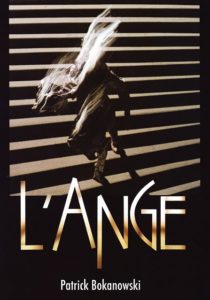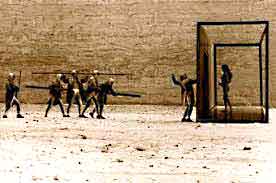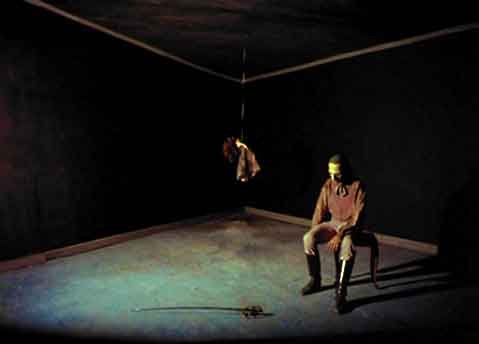 Here’s one for you art movie buffs: a stunningly visualized, wordless exercise in dreamlike strangeness that’s an altogether remarkable example of impressionistic razzle-dazzle.
Here’s one for you art movie buffs: a stunningly visualized, wordless exercise in dreamlike strangeness that’s an altogether remarkable example of impressionistic razzle-dazzle.
…impressionistic razzle-dazzle.
Filmmaker Patrick Bokanowski is one of France’s top animators, even though his work, consisting mostly of a handful of short films (including 1974’s DEJEUNER DU MATIN and 1992’s LA PLAGE), is little known to the world at large. That’s also true, unfortunately, of 1982’s L’ANGE (THE ANGEL). Five years in the making, it’s Bokanowski’s only feature length work, and his undoubted masterpiece. Thus far the film’s only appearance on home video has been via an overpriced VHS—let’s hope that situation changes, and soon!
In some odd, irrational universe, an indistinct figure ascends a winding staircase that becomes a literal stairway to heaven. Along the way we become privy, in the rooms and corridors bordering the stairs, to several bizarre figures stuck in repetitive loops: a man jousting with a doll, a servant woman dropping a jug over and over, a bunch of anonymous bookkeepers confined to an overflowing library, a woman trapped in an animated square, etc. Yet all this darkness and absurdity gives way to the seeming transcendence of a blinding light that emanates from above, and eventually engulfs everything we see.
…a winding staircase that becomes a literal stairway to heaven.
Obviously this film isn’t for everyone, lacking as it does anything resembling a story or characters, or even a coherent setting (dark hallways, partially glimpsed shapes and featureless rooms are constants). Even the title character, a winged giant supposed to appear at the end (but cut from the scenario for budgetary reasons), is nowhere to found.

Yet Patrick Bokanowski’s technical virtuosity is undeniable. The images are often indistinct, yes, but have a glittering surreal beauty. Michele Bokanowski contributes a suitably avant-garde string score that works in perfect conjunction with the images in the way it begins with great subtlety and gradually builds to a noisy, twanging din.
In some ways the film is like a Philip Glass composition come to life in its hypnotic (for viewers willing to surrender themselves to it) use of repetition. The figures of the film perform the same actions over and over, moving in jerky stop motion spurts—at least, those that aren’t frozen in an endless series of freeze frames (often contained within a single shot) that flash and strobe.
A cursory reading of the events of L’ANGE might suggest a metaphor of our present world, trapped in an endless loop of triviality, or perhaps the ascension of a human soul through the afterworld. Both interpretations are too pat. The film, ultimately, is a gorgeously mounted, deeply haunting puzzlement that will affect each viewer differently.
Vital Statistics
L’ANGE (THE ANGEL)
Kira B.M. Films
Director/Producer/Screenwriter/Cinematographer/Editor: Patrick Bokanowski
Cast: Maurice Baquet, Jean-Marie Bon, Martine Couture, Jacques Faure, Mario Gonzales, Rene Patrignani, Rita Renoir, Alain Solomon, Dominique Serrand, Nicolas Serreau

